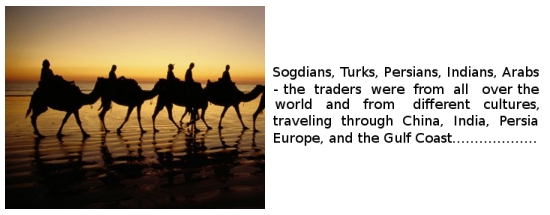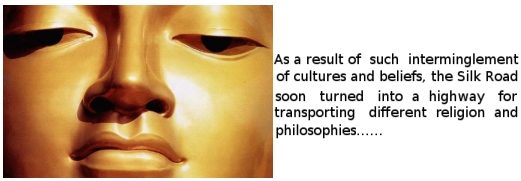Rituparna Kakati | 11 Sep, 2008
In 2005, a newspaper report revealed the story of a Kenyan girl who successfully traced her ancestry in China 600 years after the legendary Chinese sailor Zheng He's fleet of 25,000 ships had sunk while on a peace and trade mission.
Beijing confirmed the fact after DNA testing and awarded the girl a scholarship to study.
This Chinese story is a nice one, and what strikes me most is the fact that legendary Zheng's ships certainly traveled farther than the distance most of the historians believe today.
This story also emphasizes the fact that trade in the ancient world was often performed at a much larger scale than that we, the globalized world, usually imagine.
Globalization - past and present
The term 'globalize' was first attested by the Merriam Webster Dictionary in 1944, and in considering the history of globalization, many a scholar focuses on events since 1492. But in reality, globalization started long before 1942 - long before Zheng He led his expeditions to 'the Western Ocean' - long before the earliest known long-range relays of cargo around 9000 BCE.
Globalization, in its earliest phases, started right from the first movement of people out of Africa into other parts of the world. This historical process gradually picked up speed in later period with the emergence and growth of trade and supply routes in different parts of the world and in different periods. The commercial network of trails and roads, rivers and sea routes, have grown larger and more intricate since time unknown playing a crucial role the emergence of today's world - the world of global trade.
The Silk Road
In the history of 'ancient globalization' - the growing integration of economies and societies around the world of antiquity - the most important trade route was the Silk Road - a transcontinental trade route that linked Europe and Asia thousands of years ago and long before the advent of the Global Economy of our era- an incredibly extensive trade network that extended from China through Java, India, Persia, Egypt, Somalia, Arabia till it reached Southern Europe.
The Silk Road

The Silk Road extended 8000 km, connected 3 continents, and it bustled with activity for more than 1000 years. But the significance of this trade route in the history of human civilization is much more than these facts signify. The Silk Road bridged almost all the major civilizations in the world of its age and played a catalyst role in the development of some of the greatest civilizations of the ancient world - Egypt, China, India, Persia, Arabia, Byzantium and Rome - civilizations which helped to lay the foundations for the modern world in several respects.
The Silk Road created a 'global marketplace' for the first time in human history - a marketplace that successfully spread different cultural ideas, beliefs, and lifestyles across East and West, North and South to 'globalize' the world. Besides serving as the conduit or goods, the Silk Road was a super highway of its age for the transmission of cultures, knowledge and ideas.
Story inside the story
The Silk Road originated in the 2nd century BC from a desire for military and political purpose instead of for trade. Due to Xiongnu's repeated invasion, Han Wudi, the seventh emperor of the Han Dynasty in China, sent his envoy Zhang Qian in 139 BC to seek an alliance with the Yuezhi of modern Uzbekistan. However, on the way to the Western Regions, Qian was forced to pass through land controlled by the Xiongnu who captured him and enslaved him.
Countries described in Zhang Qian's report

After ten years, Zhang Qian was eventually able to escape and continued his journey to the Central Asia and finally reached to the land of the Yuezhi who refused to ally with Han Empire. Zhang spent a year there and documented the cultures, lifestyles and economy of the Yuezhi people. In 125 BC, Zhang returned to his native land to inform the emperor that many sophisticated civilizations existed to the West.
Thus, Zhang Qian's mission opened up to China an unknown and new part of the world. Following the report, several Chinese missions were sent throughout the end of the 2nd and 1st century BC which initiated the development of the Silk Road.
A continuous journey !
In 1870s, a German geographer Ferdinand von Richthofen coined the term 'Silk Road' which implies a continuous journey. But in reality, very few travelers traveled the route from end to end. The Silk Road comprised of many trade routes across Eurasia in various directions. Goods were transacted from one market to another and each of the transactions increased the cost of end products. In addition, traders who came from different parts of the world brought with them varied items which were traded for other items.
Silk - the hottest luxury good
When the Silk Road was first established, silk was not the principle commodity of trade. But as the rich and noble families of Rome grew fanatic over silk, it became the hottest luxury good moving along the Silk Road. During the Tang dynasty (June 18, 618 - June 4, 907) almost thirty percent of the trade on the Silk Road was comprised of silk. But the caravans along the Silk Road also carried a vast range of other products such as gold, grapes, pomegranates, rugs, glass, jade, gunpowder, paper, compasses, bamboo, chrysanthemums, etc. These goods were not available in certain places and it made it valuable if they were obtained from a great distance away.
Travelers from all over the world
The caravan was the most popular along the Silk Road and trade was carried on against great odds - through waterless deserts and snowbound mountain passes. On the route, there were several caravansaries which were rest places to the traders to gather, talk about the events that happened along the road, and plan their routes based on how well the trade was in the approaching city, and how safe the route was. Sogdians, Turks, Persians, Indians, Arabs - the traders were from all over the world and from different cultures, traveling through China, India, Persia, Europe, and the Gulf Coast and collecting and selling items to different cultures.

A merchants' paradise
Thus, the Silk Road was a merchants' heaven and a consumers' dream. But it was not a mere channel of trade: the trade route was the means of spreading different cultures, beliefs, spiritual wealth and religious doctrines. As the traders on the Silk Road originated from different parts of the world, they carried their own cultural lifestyles around with them. They were missionaries of their own personal cultures and sometimes they adopted other beliefs as well.
Cross cultural exchange
As a result of such intermingling of cultures and beliefs, the Silk Road soon turned into a highway for transporting different religion and philosophies. Mecca being one of the hottest trading spots, the Islamic beliefs spread extremely quickly. As the religion continued to grow, many countries started to model their governments around the Quran and the teachings of Muhammad.
Buddhism which became the main religion of the mighty Kushan empire expanded to China and replaced ancient Zoroastrian cults prevalent in Khorezm, Sogdiana and Bactria. And even at the beginning of our era, Christianity eventually reached Central Asia and China via the Silk Road. Some other examples of what was transported along the Silk Road also include mathematics and science, Arabic system of numbers, and astronomical ideas of the east.

Thus, the Silk Road was the crossroad between civilizations, peoples, and cultures. The traders with their culturally significant products and different lifestyles - their religions and beliefs that were passed on from traveler to traveler, place to place - and their great caravans who made the tedious journeys across some of the most inhospitable territory on the earth successful - all combined along the Silk Road to make the first global marketplace in the history of civilization.
Once the most prosperous trade route on this planet, the Silk Road is no more - busy streets, wealthy cities, solid ramparts - all are now submerged in the vast desert. But the history of the Silk Road generously left us memories of our ancestors who laid this unique overland highway from East to West - and a fascinating global marketplace without which many things today would be impossible.
(* The author, Writuparna Kakati can be contacted at rituparna@tradeindia.com)